
Wildlife Program report: Aug. 16-31, 2023
Providing Recreation Opportunities
Travel Management: Andersen and Browning continued having discussions with land managers about conducting trail inventories on wildlife areas. Browning wrote a request for proposal (RFP) for an inventory project on Wooten, Cowlitz and Scatter Creek wildlife areas. The Quincy Lakes trail conditions assessment contract is in its final stages. TREAD is writing the report that includes recommendations for trail use.
Conserving Natural Landscapes
State-Tribes Recreation Impact Management: [GA(1] [C(2] Washington Department of Fish and Wildlife (WDFW) is working with federally recognized tribes and other state agencies to develop a framework for managing recreation impacts on state lands. The Steering Committee met on Aug. 17. The meeting focused on developing a structure and scope for the work and discussion of contracting third party facilitation. The next steering committee meeting is scheduled for Sep.7.
Providing Education and Outreach
The Ambassador Program: The Ambassador Program has completed two more weeks of programming. There was greater visitation at the LT Murray Wildlife Area due to the coming of hunting season. There are three weeks left, and Browning and Washington Trollers Association (WTA) are pivoting the program to new locations on the west side where there is more visitation.
Lands Advisory Group Strategic Planning: To diversify participation and increase support from local communities, the strategic plan will provide statewide improvements and identify opportunities to enhance the roles of advisory committee members. These recommended changes will benefit staff members and community experiences while increasing public involvement in land management practices. Staff members will engage internal and external stakeholders in this planning process which is expected to continue through 2025.
States Organization for Boating Access (SOBA) Symposium: Washington Department of Fish and Wildlife co-sponsored and attended the SOBA symposium held in Tacoma during the last week of August. Lands Division was represented by Belson. Other WDFW attendees and presenters included Region 6 field operations, Real Estate Services, and Capital and Asset Management Program (CAMP). The director gave a welcome speech to attendees on the opening day.
Managing Wildlife Populations
Bighorn Sheep Monitoring: District Biologist Wik and Assistant District Biologist Vekasy traveled to Oregon to recover a bighorn sheep collar that had sent a mortality alert. The collar on a yearling ram was shed on a fence line. Placement of collars on older lambs, particularly rams, has yielded important new information on dispersal movements, highlighting an increased risk of contact with domestic sheep. Multiple rams have now traveled through domestic sheep grazing allotments that had previously not been recognized as being in bighorn sheep range.
Upland Game Birds: Biologist Brinkman recorded observations of upland game birds while conducting deer surveys and submitted these observations as part of a larger scale effort to document breeding productivity of upland birds statewide.

Elk Calf Survival Study: Scientific Technician Moberg continued monitoring collared elk calves in the Blue Mountains. She conducted five mortality investigations, of which three were shed collars caught on fence lines and two were likely cougar predations. Field necropsies on carcasses, along with predator DNA sampling, help to support predation evidence.
Habitat Development Activities: Biologist Baarstad contacted seed vendors, co-workers, and volunteers to begin planning fall habitat development work. Several projects are planned for implementation over the next two months.
Deer Surveys: Biologists Lowe and Brinkman conducted deer pre-hunt ground surveys that will be used to estimate buck to doe ratios for white-tailed deer in District 2. These surveys are conducted for around two to three hours in the morning or evening when deer are most active, and the surveys consist of driving routes through different parts of the district and recording the number of individuals and composition of each group of deer observed (i.e., how many does, fawns, and bucks). Mule deer are often encountered during these surveys, and composition of these groups are also documented.


Chronic Wasting Disease: Acting Private Lands Biologist Nizer took Chronic Wasting Disease (CWD) samples to the Spokane regional office for processing. Nizer also checked Department of Transportation pits for deer carcasses. Nizer also checked in with Pacific Pride/Java Bloom to ensure having a check station at that site would still be ok this fall.
Private Lands Biologist Hadley worked with W. T. Wooten Wildlife Area Wildlife Area Manager Dingman to create a CWD poster for the Rainwater Wildlife Area to be put out for hunters to see. Private Lands Biologist Hadley printed and laminated several posters and coordinated to meet with Dingman next week.
Chronic Wasting Disease Operations: Natural Resource Technician Heitstuman checked local pits for CWD samples. Several road-killed deer were also recovered and disposed of due to advanced decomposition.
Providing Recreation Opportunities
Fire Damage: The Gray Fire, which started late in the week west of Spokane, swept through the West Medical Lake Access Area and burned down the fiberglass toilets. This occurred when Dziekan and Brant were off for the weekend. They may be unable to closely inspect the site until the fire is completely extinguished. Swanson Lake Wildlife Area Manager Finch will be working with Dziekan to fill out the damage report and complete follow-up work, including replacing restrooms and posting signage onsite and online. Statewide Access Area Manager Belson and Sherman Creek Wildlife Area Manager Anderson will assist as needed.
Badger Lake Gate: Access Manager Dziekan removed half of the gate at Badger Lake last spring and brought it back to the shop to reinforce it with some new welds. The gate is perfectly functional, but adding additional metal should prevent unauthorized access to the boat launch area when the gate is locked for the season. There have been issues with vandals cutting the lock off the gate so they could get into the access area. Dziekan covered the top of the gate with a new round plate and added some more metal to the sides as an extra measure. The bottom is still open, it needs to be open to allow access the lock, but there isn’t enough room at the bottom to open bolt cutters and cut the lock hasp. It was tested in the field before it was secured.

Tucannon Lakes: Natural Resource Technicians Tritt and Jensen continued checking the lakes and fish screens to make sure everything is working properly. They cleaned up trash around the lakes and cut trees down in the Blue Lake overflow area. Tritt and Jensen completed installation of the new spotting scope at the ADA accessible pad at Rainbow Lake. They used the tractor to move some large boulders to protect the spotting scope from being backed into.



Turnbull Hunt By Reservation: Acting Private Lands Biologist Nizer and Natural Resources Technician Rumiser met with the Turnbull Wildlife Refuge manager to post hunt by reservation and boundary signs for the new 1,883 turkey access site. While posting the property Nizer and Rumiser stumbled across a bull moose. This access site will provide great access for turkey in the future and for viewing beautiful wildlife.

Cummings Creek Road: Wildlife Area Manager Dingman and Natural Resource Technician Tritt took the all-terrain vehicles to check Cummings Creek Road. There are several places where the trees are leaning over the road, making it difficult for horseback riders. Completing clearing of the road is a priority before the upcoming hunting seasons.
Landowner Hunting Permit Application: Acting Private Lands Biologist Nizer worked with Columbia Plateau Wildlife Management Association to submit their Landowner Hunting Permit application for the three-year seasons. Nizer also reached out to Officer Copenhaver to see if he would be willing to attend a meeting that they will be having on Sep. 14. This will allow them to get familiar with the officer that covers their area.
Mentored Youth Hunt: Acting Private Lands Biologist Nizer coordinated with Jason Cushman with Pheasants Forever of Spokane to organize the mentored youth hunt on Sep. 16. The sites were reserved for the youth hunt and birds will be held back to release at the designated sites.
Providing Conflict Prevention and Education
Contract Range Rider Check-In: Wildlife Conflict Specialist Kolb conducted a check-in with a contract range rider. Jacobson was also informed of a contract range rider who may be interested in riding in his area of responsibility.
Potential Contract Range Rider Calls: Wildlife Conflict Specialist Wade spoke with two potential range riders and provided them with information regarding the program.
Wolf Activity and producer Contacts Anatone Area: Wildlife Conflict Specialist Wade worked to contact multiple producers to gain access to their private property for wolf related operations this week. Wade worked to inform the District 3 wolf team of private lands access for the operations. Kolb, Natural Resource Technician Heitstuman, and Wade met with an Anatone area producer to deploy a radio activated guard (RAG) box on their property. Heitstuman and Wade returned later in the week to build an enclosure around the RAG box to prevent damage from cattle and wildlife in the area. The RAG box was deployed in response to a confirmed wolf depredation in the pasture. Wade also discussed grazing rotations with another producer who is running out of viable pasture outside of the W139 activity center.

Wolf Depredation: Natural Resource Technician Harris, Wildlife Conflict Specialist Samsill, and Officer Thoma met with a producer to investigate an injured cow that was discovered on a grazing allotment in the Smackout pack territory. Staff members confirmed that the cow was injured during a confirmed wolf depredation event. The cow will stay at the producer’s homeplace for the remainder of the grazing season while it recovers from its injuries.
Conserving Natural Landscapes
Project Proposals: Natural Resource Technician Harris worked on writing proposals for habitat restoration projects to be conducted in 2024. Harris also met with two landowners that were interested in carrying out riparian area restoration projects on their land.
Asotin Creek Boundary Stock Fence: Wildlife Area Manager Dice looked at 1,000 feet of stock fence built by wildlife area staff and University of Idaho interns at Cook Ridge. The fence closed a hole left by the contractor who didn’t finish his job and has now left the area. Dice also locked the gate going into WDFW land at Cook Ridge and posted agency signs. The contractor sent a crew over to finish cleanup work in order to get paid. Their work wasn’t exactly what we were looking for but will have to do.


Medical Lake Gray Fire: The Medical Lake Gray Fire that started on Aug. 18 destroyed several homes also did some damage to WDFW West Medical Lake access area. The fire destroyed four fiberglass outhouses along with countless signs, fences, and several large ponderosa trees will need to be cut down. Access Manager Dziekan used plywood to cover the open toilet pits after removing the outhouse debris over the openings to make the area safer for the public. Dziekan took many photos and documented the damage in a report that was submitted to Wildlife Area Manager Finch.
This week, Budget Analyst Nelson, Camp Engineer Hansen, Dziekan, and Finch met on teams to discuss the damage caused from the Gray Fire and estimate the cost to repair the damage. Nelson will be submitting a funding request soon to cover the damage repairs. Dziekan is also documenting the hours doing cleanup work.


Habitat Proposal: Natural Resource Technician Harris wrote and submitted a funding proposal for a riparian restoration project on the Vetter Farm in Stevens County. Harris met with Biologist Stetson at the project site to discuss the project.
Providing Education and Outreach
Mentored Youth Deer Camp: Wildlife Conflict Specialist Samsill helped to coordinate and plan the upcoming Third Annual Chris Christensen Memorial Youth Deer Camp. The camp will take place at the Sherman Creek Wildlife Area the weekend of Aug. 24 through Aug. 27.
Hunter Education: Wildlife Conflict Specialist Kolb continued coordination throughout the week on hunter education support for future classes.
Chronic Wasting Disease Billboard: Wildlife Biologists Prince and Turnock, Ungulate Research Scientist DeVivo, Access Manager Dziekan, and Chronic Wasting Disease Technician Brant installed a CWD billboard south of Chewelah. The billboard space was provided by the Northeast Washington Wildlife Group and the sign will be in place from now until mid-December.

Northeast Washington Fair: Wildlife Conflict Specialist McCarty managed a booth with Assistant District Biologist Turnock at the Northeast Washington Fair.
Natural Resource Technician Harris staffed the WDFW booth at the Northeast Washington Fair in Colville.
Spokane Interview: Wildlife Conflict Specialist McCarty spoke with a reporter that was experiencing squirrel damage to his potted tomato plants and wanted to write a newspaper article on squirrel damage in urban areas.
Hunter Education: Wildlife Conflict Specialist Kolb contacted newspapers in Walla Walla and Columbia County about up-coming hunter education opportunities in the area in the event the editors want to share the information with their readers.
Another Unauthorized Field Camp: Fish and Wildlife Officer Thoma successfully got a set of unauthorized residence campers on the western end of Sherman Creek Wildlife Area to clean up and leave their site last week. Wildlife Area Assistant Manager Palmer spotted a new camp, near the previous one along the south fork of Sherman Creek. This new camp appeared to belong to a single person but was unoccupied and in disarray. Palmer cleaned up the site and threw the debris in the dumpster at Sherman Creek Wildlife Area headquarters.
Columbia County Fair Booth: Wildlife Area Manager Dingman and Fish Manager Trump put the WDFW Fair booth together.



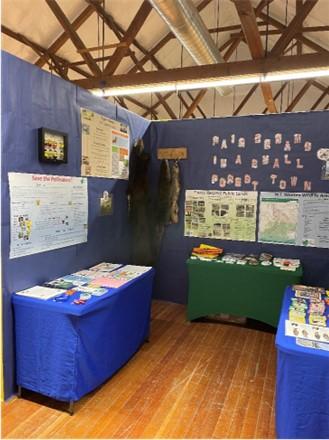
Conducting Business Operations and Policy
Lethal Removal Recommendation: Wildlife Conflict Supervisor McCanna spent a considerable amount of time writing the WA-139 wolf group lethal removal recommendation. The District 3 wolf team provided edits and comments. McCanna worked with the Attorney General office for final edits and comments. McCanna sent final recommendation to Region 1 Director Kuttel and Director Susewind.
The Sherman Creek Wildlife Area office received a new heat pump heating and cooling system on Friday. This replaces an old electric baseboard for heat and opened windows and a fan for cooling.


After Action Review: Wildlife Conflict Supervisor McCanna facilitated an after action review after a depredation in District 3. The cause of death was non-depredation.
Wildlife Conflict Supervisor McCanna facilitated an after action review for the WA-139 group recommendation and lethal removal operation. Notes from the meeting can be found at After Action Review.
Managing Wildlife Populations
Wildlife Response–Bats: District Wildlife Biologist Jeffreys responded to two different calls from concerned members of the public regarding bats in need. These kinds of calls are typical for this time of year as the breeding season winds down and young, inexperienced pups are now on their own in the world, learning how to be a bat, and sometimes finding themselves in unsafe situations.
The first call was from an employee at a local business who was concerned for the safety of a bat (one of the Myotis species) clinging to a wall just a couple of inches above the ground. Not only was this bat easily within reach of any passing predator, but it was also just a few inches away from the office front door and near a lot of pedestrian traffic. This is a good example of a young bat that doesn’t quite understand how to find a suitable day roosting location where it will be safely tucked away from predators and insulated from the heat of the day. Luckily, this employee cared for the bat’s wellbeing but also knew to never attempt to handle a bat herself. Biologist Jeffreys drove out to the business, donned gloves, and gently removed the bat pup from the wall, placed it in a shoebox, and transported it to some trees across the street. Once there, Biologist Jeffreys removed the bat from the shoebox and placed it about six feet up in the fork of a shady tree, where it could crawl under some bark, and wait out the day before taking off again at night to catch some tasty bugs.

The second call regarding a bat in trouble came from a homeowner who was horrified to find a bat (also a Myotis sp.) stuck to a glue trap she had placed outside to kill wasps. Unfortunately, this disturbing event is all too common. Thousands of bats, birds, lizards, and other wildlife (even house cats on large board-style glue traps) die slow, excruciating deaths every year after coming into contact with sticky fly paper or a glue trap and not being able to free themselves. Please NEVER use glue traps or fly strips. Consider wildlife-safe and pet-safe alternatives, such as reusable hanging traps with small entrances that hornets or wasps crawl into to get at a protein or sugar source inside. These kinds of traps have the added benefit of not using any toxic chemicals such as those found in sticky traps.

Biologist Jeffreys was able to carefully remove the bat from the sticky trap and, after many rounds of washing off and rinsing out most the remaining glue, the bat began vocalizing and getting more mobile again. However, his wings were still too sticky to allow him to fly, and a bat that can’t fly and catch bugs on the wing is a dead bat. So, Biologist Jeffreys and the very helpful and compassionate homeowner realized more help was needed and called a bat rehabilitator on the west side, who agreed to take the bat pup in for further treatment.

Fortunately for this little bat, the homeowner was heading to the west side the next day and was all too happy to drive up to Bothell and drop him off. The pup is currently in the care of this bat rehabber now, and she reported that he has a healthy appetite and is doing well. He is not out of the woods yet, and it’s possible he may have ingested some of the highly toxic glue, but let’s hope this little guy will make a full recovery and be flying the night sky again soon!
Wildlife Population Monitoring – Planning and Coordination
Mule Deer: Biologists Jeffreys and Eilers met with WDFW Ungulate Specialist Bundick to discuss ways to improve mule deer population surveys and monitoring in both the East Slope Cascades herd and the Columbia Plateau herd. Now that analysis has been completed, for three years of GPS data transmitted by collared does captured in 2020, biologists have learned that Highway 2 serves as a barrier between deer populations that is rarely crossed. The deer on either side exhibit spatially distinct patterns of home range and migration. This means that what has always been categorized as the Chelan subherd is actually comprised of two separate populations: one consisting of deer that winter in the Wenatchee Foothills region of Chelan and Kittitas counties (now known as the Wenatchee Mountains subherd), and one consisting of deer that winter north of Hwy 2 and south of Lake Chelan (the Chelan subherd). To monitor deer populations more accurately in District 7, biologists are working to redesign abundance and ratio surveys to reflect these new findings. For winter 2023, biologists plan to reallocate sampling units for aerial surveys as well as distribute more than 20 game cameras across known high-use migration corridors used by the Wenatchee Mountains subherd.
Mountain Goats: Biologist Jeffreys continued working with Ungulate Specialist Moore, State Wildlife Veterinarian Mansfield, and partners at U. S. Forest service and National Park Service to coordinate winter 2023-2024 capture and collaring efforts for mountain goats in the Lake Chelan Basin. This is a highly challenging project to coordinate due to the extremely rugged and inaccessible terrain as well as multiple, different land jurisdictions, much of it federally designated wilderness. Biologists are eager to make it happen this winter after only being able to collar two goats in January 2023 instead of the intended twenty. Both herds in the Lake Chelan Basin have been decreasing in number for years, and biologists are striving to learn more about these herds and the factors contributing to their decline.

Fisher Surveys: Biologist Jeffreys continued planning and coordination efforts for upcoming fisher survey work. The fisher (Pekania pennanti) is a State Endangered, house cat-sized, member of the mustelid family that was once common throughout Washington but was extirpated by the mid-1900’s due to over-trapping, incidental human-caused mortality, and habitat loss. Following an initial fisher reintroduction effort in the Olympic Peninsula from 2008 to 2012, WDFW and other partners such as National Park Service (NPS), U.S. Fish and Wildlife (USFW), and Conservation Northwest reintroduced fishers to the Cascade Mountain Range from 2015 to 2020. Since then, fishers have dispersed from the reintroduction sites, created home ranges in historically occupied fisher habitat, and successfully reproduced, all encouraging signs for the future of this species in Washington.
Fisher population monitoring is ongoing in the Cascades, and biologists with WDFW, NPS, USFS, and partners, such as Conservation Northwest and the Cascades Carnivore Project, are gearing up for a major survey effort taking place October 2023 through May 2024 to assess fisher distribution and occupancy throughout the region. This survey will involve placing baited camera stations in forested habitats within pre-selected grid cells throughout The Cascades in Washington. Chelan County in District 7 has the highest number of grids of any district in the state. Biologists must have all camera stations up and running by Nov. 1, but staff members don’t want to place the cameras too early as the strong-smelling scent lure used to attract fishers will also attract bears, which can destroy the bait stations. Thus, biologists will place all cameras between Oct. 1 and Oct. 31. It is a major undertaking as many of these sites require hiking into them while carrying heavy gear. Biologists will return to take down the camera stations and collect memory cards when the snow begins to melt (May through July) and look forward to seeing what species of wildlife appear in the photos. Aside from gaining valuable information about where fishers occur, these camera stations also afford biologists the opportunity to learn about other carnivore species of concern, such as lynx, wolverine, wolf, and Cascade red fox.


Watchable Wildlife: As the hot summer months come to an end and fall approaches, now is a good time to see snakes while out hiking or in your own backyard. Washington is home to more than a dozen snake species, only one of which is capable of harming humans with a venomous bite (but very rarely does as it strongly prefers to avoid humans) – the northern Pacific rattlesnake (Crotalus oreganus). All other snakes you may come across here are harmless to humans, such as the gopher snake (Pituophis catenifer) and northern rubber boa (Charina bottae), both pictured below. With the onset of cooler weather and shorter days, snakes are on the move and getting ready to make their way back to overwintering areas (hibernacula) in sheltered places such as underground burrows or rock piles where they remain largely inactive for six or seven months before emerging again in the spring. All snakes in Washington eat rodents (among other things) and thus are important allies in pest control, keeping the populations of rats and mice down. Please let these beautiful and beneficial creatures live their lives and respect their right to coexist peacefully alongside us.


Northern Leopard Frogs: Biologist Morris helped Leopard Frog Biologist Nason with checking leopard frog enclosures, measuring tadpoles and frogs, and releasing sufficiently mature frogs. The northern leopard frog is classified as endangered by the state of Washington. Recovery efforts include breeding and releasing the frogs to try and increase population numbers in the Columbia Basin.


Managing Wildlife Populations
Raptors: Biologist Eilers joined U. S. Fish and Wildlife Service and HawkWatch International (HWI) in transporting and setting up the seasonal HWI migration site on Chelan Ridge near Cooper Mountain. This site is one of HWI’s many long-term raptor migration monitoring sites, the purpose of which is to document species occurrence and abundance for all diurnal raptors migrating south to their wintering grounds.
“The primary objective of these efforts is to track long-term population trends of diurnal raptors throughout primarily western North America. The information gathered enables us to better understand the life histories, ecology, status, and conservation needs of raptor populations in North America. Raptors feed atop food pyramids, inhabit most ecosystems, occupy large home ranges, and are sensitive to environmental contamination and other human disturbances. Therefore, they serve as important biological indicators of ecosystem health. Moreover, due to the remoteness and widespread distribution of most raptor populations, migration counts likely represent the most cost-effective and efficient method for monitoring the regional status and trends of multiple raptor species.” -Hawkwatch International - Migration Network
The HWI Chelan Ridge site is open to the public for viewing and education – although 4WD or AWD is highly recommended to get there! But trust us, the panoramic views (and raptors) are worth it! If you have a group of six or more people, it is asked that you schedule your visit beforehand at HWI Migration Site Group/Extended Visit Schedule (jotform.com).




Bats: Biologists Jeffreys and Eilers wrapped up the bat monitoring season with a final emergence count at a U.S. Forest Service warehouse near Lake Wenatchee. Although well over a hundred bats had been counted here in July, few bats were observed exiting the roost on this second count. This suggests that juveniles are now self-sufficient and mothers and young can now freely disperse to other roosting sites for the remainder of the active season prior to hibernation.
A young Myotis bat was found sleeping on the main door of WDFW’s Wenatchee District Office during the day. This young male is likely still learning how to be a bat, and as he gets older and wiser, he will learn to choose safer, less-exposed roosting sites that afford better protection from predators and the elements. Biologists surmise this juvenile bat spent the night foraging on insects attracted to the flood light right outside the office and then tucked himself in for the day by the front door hinge. Using gloves, Biologist Eilers relocated the little bat to WDFW’s back warehouse where he could rest undisturbed before continuing his insect removal services after sundown.
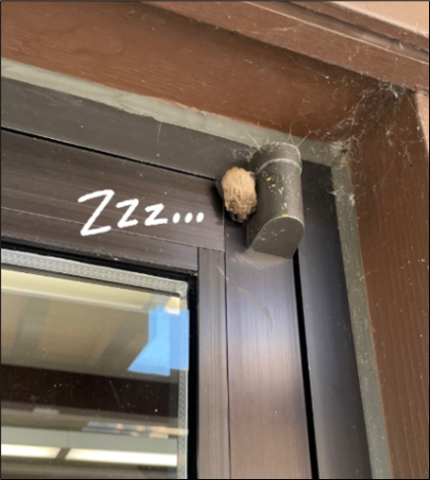


Biologist Eilers is a trained and vaccinated professional. If you encounter a bat roosting low during the daytime, please leave it be. Watch the video at the link below for information on what to do if you encounter a bat in your home.
Sandhill Crane Update: Back in May, a state endangered pair of sandhill cranes successfully hatched two colts (baby cranes) in the Big Valley Unit of the Methow Wildlife Area. Around early July, a dedicated group of local volunteers, who monitor the cranes daily, reported one colt had disappeared, likely due to predation. Although, the good news is, as of Aug. 31 we have a fully-fledged juvenile crane flying strongly with mom and dad. The remaining juvenile is approximately 14 weeks old and was recently photographed by a local resident nearly six miles away (as the crane flies) at Twin Lakes, safely accompanied by the adults. Within the next few weeks, our trio of sandhill cranes will likely begin migrating to their wintering grounds in the Southwest. The juvenile is expected to be fully independent around ten months old, at which time it should join a flock of other nomadic juveniles until it hopefully forms a breeding bond between the ages of two and seven years old.
Fun Fact: Did you know, cranes are among the oldest living birds on earth and according to the Cornell Lab of Ornithology, the earliest unequivocal sandhill crane fossil is estimated to be 2.5 million years old.
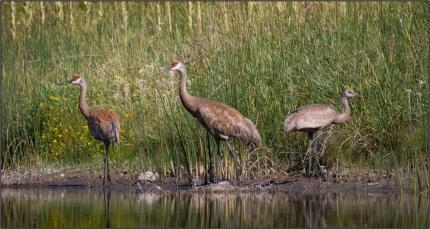
Scotch Creek Bird Flight Diverters: Staff members worked with the Okanogan County Public Utilities staff members to have bird flight diverters and perch deterrents installed on the power lines and poles around the headquarters office. The riparian area shrubs adjacent to the office provides quality winter forage for sharp-tailed grouse and is frequently used by sharp-tails during the winter. Power lines are a collision hazard for sharp-tails and the diverters will make the lines more visible to sharp-tails.

Wildlife Surveys: Biologist Morris met with two landowners to review their Safe Harbor Agreements and site plans for the Columbia Basin pygmy rabbit. Morris and the landowners discussed what was included in their site plans, which provides the background of their property enrolled in the agreement and what activities on their land are covered under the Safe Harbor Agreement. These Safe Harbor Agreements in Grant and Douglas counties are very successful in protecting critical pygmy rabbit habitat while at the same time providing regulatory assurances to the landowners that the presence of pygmy rabbits won’t negatively affect their farming operations.
Pygmy Rabbit Release Effort Monitoring: Pygmy rabbit crew with the assistance of District 7 staff members and volunteers conducted monitoring for pygmy rabbit dispersal and burrow establishment on the Rimrock release area. We documented 12 likely active burrows, both in and outside of the release pens, with some fresh sign of rabbits up to 300 meters from the pens. Game cameras were set at some sites to confirm occupancy there. We will conduct similar monitoring on the Palisades release area soon.


Rattlesnake Issue: Over 10 years of pygmy rabbit work and we have run into very few rattlesnakes. This year however is very different. We have encountered them almost on a weekly basis in the release pens and have found at least three that were entangled in the fencing. We began looking into the burrows with our burrow camera and found them occupying the rabbit burrows. Not really seeing any benefit to this cohabitation, we have removed two rattlers from our rabbit pens this summer, releasing them miles away.


Providing Recreation Opportunities
Hunter Access Contract Renewals: Biologist Cook worked on contacting around 20 landowners to renew Hunter Access contracts that are set to expire this year. Most landowners quickly wanted to renew contracts and a few wanted to remove their property from the Hunter Access program. Cook will continue to contact landowners and begin entering the contract information for contract creation.
Hunter Access: Big game hunters are beginning to plan for the fall hunting season, and Biologist Morris helped several hunters with their planning by providing information about private lands and public land hunting opportunities within their units.
Hunter Access: Private Lands Biologist Braaten began working with cooperating landowners getting permission slips and signage ready for hunting seasons in Douglas and Grant counties.
Hunter Access for Youth Hunters: Private Lands Biologist Braaten was contacted by wildlife area staff members regarding a hunter access opportunity near Loomis for youth deer. Permission was given to provide landowner contact info.
Beebe Springs: In early August, wildlife area staff members worked on repairing pond levelers at Beebe Springs Wildlife Area. These pond levelers are designed to drain water from the beaver pond without affecting the beavers. The repaired pond levelers had been pushed around and were no longer flowing. Hopefully with the repairs to the pond levelers the trail will flood less often.

In Swakane Canyon, the irrigation line that supplies water to the shrub plots broke in several places due to an increase in water pressure from a repair further up the line, staff members spent several weeks patching the line and making improvements.
Staff members took advantage of the hottest parts of the summer to catch up on training, and plan for the upcoming year. They also started to monitor amphibians and inventory species found on the wildlife area, which will be a focus going forward. Pearson’s Pond in Swakane Canyon was surveyed and long toed salamanders and Pacific chorus frogs were found.

Water Access Manager Harmon and Assistant Manager Steele and Columbia Basin Wildlife Area staff members started a heavy-duty swing gate installation at the entrance to the Seep Lakes east of the Potholes Reservoir.
Manager Harmon and Steele also checked the progress of a boat launch bank stabilization effort at the Glenn Williams access site on the Potholes Reservoir.




Providing Recreation Opportunities
Lake Lenore Target Shooting Range: Lands Operations Manager Finger drafted a grant proposal for the Lake Lenore Target Shooting Range for initial review, budget development, and consideration of cultural resource survey needs and budget.
Pheasant Release Meeting: Wildlife area staff members, district staff, and pheasant release staff had meeting concerning pheasant release numbers and dates. New steel shot area requirements were discussed as well, wildlife area staff will have to physically go out to new boundaries so they can be published in digitized format.
Rocky Ford Blind Repairs: Biologist McPherson and Specialist Walker had to go make repairs to Rocky Ford blind due to wind damage. Closer to season Biologist McPherson will schedule with Washington Waterfowler Association to brush in blind for the opening weekend.

Aeneas Lake Water Access Area Issues: An adjacent landowner to Aeneas Lake site had contacted complex Manager Haug over some issues at the site. Some concerns were people driving in tall grass down to the lake creating a potential fire risk and swimmers clogging the boat launch up for fishermen. We all met onsite and walked around assessing things. We came up with installing barrier rock where people were driving off road and a few other side roads to direct the public where to drive and installed some new signage by the boat launch. The contractor was contacted for estimates and timeline for job. He was able to fit us in rather quickly and get the job done in a timely manner.
Green Lake Access Area and Campground Project: Lands Manager Haug completed and submitted the Recreation and Conservation Office (RCO) application to improve the Green Lake water access and campground. The project will significantly improve campground facilities, access to the shoreline and provide better ADA components to the area. The preliminary evaluation of the project has it prioritized as three out of ten projects. At the most conservative funding level, the project would most likely get funded within the next state budget.
Hunter Access: Coordinating public access on private lands for hunting opportunities is one of the tasks private land biologists conduct. In support of this effort, Biologist Cook is working on updating a few hunter access contracts. All these contracts are currently active but need some updates.
Biologist Cook is working on implementing QR codes for hunters to use at register to hunt sites for this year. This is a continuation of work done last year and hopefully will allow for expansion of sites these will be available.
Biologist Morris met with a landowner that is enrolling approximately 700 acres in our Hunt by Written Permission Program. He went over details and expectations for this property that will be available to hunt (with permission) this fall. Biologist Morris also checked several properties to ensure signs were posted properly and in good condition before the start of hunting season.
Providing Conflict Prevention and Education
Road 14 Encampment: Wildlife area staff members found an area off Road 14 where people had driven off an established parking lot through uplands and set up an encampment. Wildlife area staff members coordinated with Enforcement Program who gave occupants a notice to vacate the area.

Seep Lakes Gate Installation: Wildlife area, access, and archaeologist staff members started the gate installation going into the Seep Lakes. Both holes for the swing gate and lock post were excavated while archeologist observed, and the swing gate side was poured. Once swing gate concrete sets, wildlife area and access staff members will pour the lock box post.
Spud Field Abandoned Car: Biologist McPherson and Specialist Walker located an abandoned vehicle off road that goes to spud field. Wildlife area staff members reported the incident to the Enforcement Program who will investigate the matter. Once the investigation is complete, the wildlife area staff members will have to remove the car and begin the process of trying to dispose of the car at a local junkyard.

Range Rider Payment Processing: Specialist Heilhecker submitted an order payment form, invoice, and activity logs to fiscal staff members for range rider payment. The paperwork is required to pay a livestock producer for range riding under a Damage Prevention Cooperative Agreement.
Responding to Bear Report: Specialist Heilhecker responded to an email about a bear at Leader Lake. The email did not include an address or phone number. She gave the reporting party her contact number and asked them to call. The reporting party has not called.
Elk Fence Inquiry: Specialist Heilhecker received a call from an orchardist who wanted fencing material. A WDFW employee had incorrectly told the orchardist he was eligible because he lived in an elk area. Specialist Heilhecker explained the limited budget requires prioritizing landowners with damage and those who have had damage prevention cooperative agreements with WDFW in the past. She also explained the cost-share fencing program along with the new requirement of a cultural resource assessment on the property.
Providing Conflict Prevention and Education
Nuisance Bear: Specialist Heilhecker called a landowner regarding a bear breaking limbs off her cherry tree. The landowner has dogs contained in a fence in her yard, but their barking does not always cause the bear to leave. They discussed nonlethal deterrence methods. Specialist Heilhecker also advised the landowner of her rights to protect her safety and her property. However, it was explained that bear hunting season is open if the landowner was interested in using a hunter to kill the bear so the meat and pelt would not be wasted.
Bear Call: Specialist Heilhecker called a homeowner who reported a bear getting into a garbage can on the front porch. The garbage can was moved to inside the garage. The homeowner stated she would notify others in the neighborhood to remove all attractants including bird feeders, pet food, and garbage.
Cougar Call: Specialist Heilhecker received a call from a livestock producer regarding missing calves. The producer believes a cougar has been taking his animals. There are no injured or dead animals to investigate. Since the livestock graze in GMU 204, the producer stated he may use tribal members to hunt cougars. Specialist Heilhecker reminded him to call if he finds any injured or dead livestock.
Reducing Deer and Elk Damage: Specialist Bridges continues to work with several landowners in assisting with efforts to decrease damage from deer and elk in tree fruit orchards.
Coordination with Local Municipality: Specialist Bridges is working with the City of Leavenworth Public Works director and various non-government organization’s to evaluate how to begin a community wide effort of reducing major attractants at garbage sites. Funding continues to be lacking, so conversations will continue to locate funding sources. An effort this large will take time to get going but early indications
Addressing a Chronic Bear Conflict Site: Specialist Bridges met with the City of Leavenworth’s Public Director to discuss fencing designs, permitting, and functionality of design with garbage pickup trucks.
Exclusion Fencing Construction: Specialist Bridges initiated and is coordinating a fencing project to exclude a domestic goat and sheep operation from an adjacent wild big horn sheep herd in order to reduce the potential of disease to the wild sheep. Specialist Bridges is working with the private landowner, Wild Sheep Foundation, and the Asotin County Conservation District. Work began on Aug. 25th and should take two to three weeks to complete.
Conserving Natural Landscapes
Douglas County Habitat Project: Private Lands Biologist Braaten worked on plans to assist a private landowner this fall with an EQUIP project in East Foster Creek Riparian Habitat Restoration Project. This will include assistance to plant 1600 plants and provide 14 rolls of fabric mulch.
Douglas County Habitat Project Jacobsen: Private Lands Biologist Braaten working with landowner to possibly assist plant sage brush within Conservation Reserve Program (CRP) that was burnt in Road Eleven Fire in 2020. Approximately 7500 plants need to be planted.
Incidental Wildlife Observations: Biologist Morris observed some fun wildlife this month, including upland game birds, deer, waterfowl, and non-game wildlife.

Supplemental Food Plot Maintenance: Biologist Cook and Technician Blanchard borrowed a MT-100 and mower attachment from the water access crew in Region 2 South. This equipment was smaller and more maneuverable than the private lands tractor and mower and able to better mow the needed areas. Blanchard and Cook mowed weed patches on the edges and ends of the food plot to reduce the seed production and spread of weeds in future years.

Conserving Natural Landscapes
Region 2 North Acquisition Presentations: Lands Operations Manager Haug presented three acquisition projects in Okanogan County in two RCO categories: Critical Habitat and Riparian. The two critical habitat projects (ranking number five and six) protect approximately 900 acres of shrubsteppe habitat and the riparian project (ranking nine out of thirteen) protects nearly 70 acres across two properties adjacent to the Similkameen River. Funding will be determined when the budget passes next year.


Sinlahekin Wildlife Area Noxious Weeds: Sinlahekin staff members continued treating noxious weeds on many of the units that make up the Sinlahekin. Staff members spent a considerable amount of time treating bladder senna and multiflora rose on the Sinlahekin Unit. They covered most of the valley within the last few weeks hiking up and down the hillsides of the valley. They are continuing treatment and have started to go back through areas that were previously treated, finding plants that were missed.


Sinlahekin Wildlife Area Shared Stewardship: Manager Wehmeyer and Assistant Manager Riley also met with Prescribe Burn Program Lead Eberlein to develop a project area for a potential cross boundary project with the Department of Natural Resources (DNR). This initial meeting helped to determine the feasibility and potential for doing the project. The next step is for staff members to meet with the DNR and go over the project idea.
Scotch Creek Wildlife Area Noxious Weeds: Staff members continued treating musk thistle on the Chesaw Unit. Recent warmer weather has caused many of the apical terminal buds to flower. Staff members will continue their control efforts through the month of August, spot treating and hand pulling seed heads as necessary. Staff members continue to treat musk thistle on the Chesaw Unit. Most of the plants have reached maturity, requiring seed head removal. This year, staff members have hand pulled approximately 30, 15-gallon bags of seed heads. Staff members will continue efforts through the end of August.

Okanogan Lands 20/20 Project Submittals: Okanogan Lands Operations Manager Haug submitted five applications for acquisitions in Okanogan County. The projects protect critical shrubsteppe and riparian habitats and increase recreation opportunities in the area. The applications will be reviewed later this month and then presented to staff members in Olympia for approval.

SAFE-CRP: Biologist Cook completed additional paperwork for two SAFE-CRP contracts in Adams County and submitted them to Natural Resources Conservation Service (NRCS). These documents were entered into the NRCS system. Private Land Biologists in Region 2 provide technical assistance to landowners for them to comply with SAFE-CRP Farm Bill contracts. These contracts result in marginal farm ground being taken out of production and planted with species of native grass and forbs for upland wildlife habitat and erosion reduction.
Biologists Morris, Braaten and Cook conducted field visits with Biologists Braaten and Cook to evaluate newly enrolling SAFE-CRP fields to determine what management or alterations are needed to provide quality wildlife habitat over the course of the contract. A total of 14 SAFE-CRP plans are being developed in Douglas County.
Safe Harbor Agreement: Biologist Morris evaluated a Conservation Reserve Program (CRP) field that requires mid-contract management. The landowner contacted Biologist Morris because they have a Safe Harbor Agreement for pygmy rabbits, and the Natural Resources Conservation Service would like them to mow sagebrush in the field. Biologist Morris assessed the field for its potential to support pygmy rabbits, and after consulting with pygmy rabbit Biologist Gallie, will make recommendations for areas to leave the sagebrush intact to maintain pygmy rabbit habitat.
Habitat Plots: Working with private landowners to restore and enhance wildlife habitat is one aspect of the work we do. Biologist Morris met with a landowner that would like to do wildlife habitat improvements on his property. They discussed possible options and looked at the spring as when the landowner wants to develop and plant shrubs around. This same landowner wants to make alterations to an ephemeral stream bed that is dry most of the year, so Biologist Morris arranged a meeting between the landowner, Habitat Biologist Pentico, and Environmental Engineer Snodgrass. They discussed options for alteration that would maintain and/or improve the health of the stream and what was needed to acquire a permit.
Biologist Morris began planning a wildlife habitat improvement project for upland game that can hopefully be started this fall. The project would benefit upland birds, big game, and non-game upland wildlife and is located on property enrolled in our Hunt by Written Permission Program.
Providing Education and Outreach
Vegetation Monitoring and Mapping Drone Survey Press Release: Biologist McPherson coordinated with Communication Consultant Lehman about what would be needed for a press release about drone missions on the wildlife area. Due to the areas where drone flights will occur, they agreed that a notice on the wildlife area website would be sufficient for the activity.
Master Hunter Discussion: Specialist Heilhecker received a call from the Master Hunter Advisory Group representative for Region 2. They discussed how and when master hunters have been used in Okanogan County and options for master hunters to earn volunteer hours.
Hunter Outreach: Private Lands Biologist Braaten called back many hunters wanting information about private lands access, hunting permits, and general hunting questions.
Conducting Business Operations and Policy
WDFW Staff and U. S. Border Patrol Meeting: Lands Operations Manager Haug, Regional Property Specialist Ramirez, Scotch Creek Manager Dupont, and Sargent McCormick met with U. S. Border Patrol staff members in Oroville to discuss the deployment of a border security communications tower on the Eder Unit. Staff members expressed their concerns with the project and the U. S. Border Patrol provided information regarding equipment and things they can do to minimize impacts on the wildlife area unit. Ramirez finalized the one-year agreement with the border patrol and staff members will work with the U. S. Border Patrol to make sure impacts are minimized with the addition of the tower.
Complying with Public Disclosure Request: Specialist Heilhecker completed a public disclosure request regarding landowner damage prevention cooperative agreements and landowner damage/kill permits.
Interview Panel Participation: Specialist Heilhecker participated in interviews for new Wolf Advisory Group members. To date, they have interviewed 11 candidates for five positions. Additional interviews will be held in September.
Meeting With Partner Organizations: Biologist Morris attended the Columbia Basin Pheasants Forever Board Meeting. The Columbia Basin Conservation District (formerly Grant County Conservation District) also had a representative in attendance. In this meeting, potential opportunities for the three organizations to collaborate on habitat projects were discussed.
Conducting Business Operations and Policy
Wolf Advisory Group: Specialist Heilhecker met with the Wolf Advisory Group (WAG) facilitator to discuss the direction of WAG.
Annual Fire Extinguisher Inspection: Biologist McPherson scheduled an annual fire extinguisher inspection with Performance Systems Integration (PSI). PSI came to headquarters and serviced all the fire extinguishers for our facility and associated equipment.
Other
Wolf Advisory Group: Specialist Heilhecker met with the Wolf Advisory Group (WAG) facilitator to discuss the direction of WAG.
Annual Fire Extinguisher Inspection: Biologist McPherson scheduled an annual fire extinguisher inspection with Performance Systems Integration (PSI). PSI came to headquarters and serviced all the fire extinguishers for our facility and associated equipment.
Other




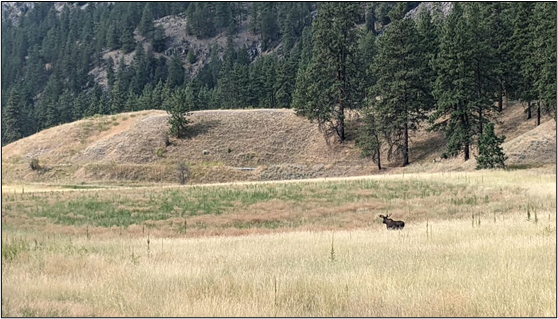











Managing Wildlife Populations
L. T. Murray Wildlife Area Signs: New signs which complement the L. T. Murray Wildlife Area green dot management map were ordered for the elk winter closure area. The signs, containing two informational signs and a map, were relatively inexpensive to replace and will be much easier for a single employee to handle.

Oak Creek Wildlife Area Elk Fence: Oak Creek Wildlife Area annual fence checks and maintenance began on approximately 40 miles of elk fence. This fence stretches from the Cowiche Unit to Cleman Mountain and the boundary with the Wenas Wildlife Area. This fence aims to reduce elk conflict during the winter by limiting movement of elk onto agricultural lands.
Duck Banding Underway Around Washington: Statewide Waterfowl Specialist Wilson assisted District 8 Assistant Wildlife Biologist Moore with waterfowl banding at the Sunnyside Wildlife Area and Bureau of Reclamation property. Swim in traps have been deployed to trap and band ducks for harvest management and to gather information on survival and distribution. The information from recaptured and reported waterfowl bands is used to model harvest, recruitment, and survival, which impact hunting regulations and sex-specific limits. Wilson assists with waterfowl banding projects throughout the state.


Providing Recreation Opportunities
Landowner Hunting Permit Coordination: District 4 Wildlife Conflict Specialist Hand met with the owner of one of the Silver Dollar ranches participating in our Landowner Hunting Permit program to coordinate special permit holders hunting opportunities. Special permit hunters were also contacted and provided hunt scheduling and contact information for the owner.
Oak Creek Wildlife Area Elk Viewing: Oak Creek Wildlife Area Assistant Manager Charlet and Natural Resource Technician Boggs installed a new ADA accessible viewing telescope at the Oak Creek elk feeding station.

Wenas Wildlife Area Lower Buffalo Access: Wenas Wildlife Area Natural Resource Technicians Trahern and Stoltenow, along with Assistant Manager Taylor, removed the ineffective cattle guard and installed a new gate post at the Lower Buffalo entrance. Wenas staff members will make a new gate, using a new latch system and install it next week. They are going away from chain and hook latches on gates and moving to spring loaded latches.
Wenas Wildlife Area Manastash Ridge Trail Name Signs: Wenas Wildlife Area Natural Resource Specialist Frame installed white carsonite posts with trail names on approved trails in the Manastash Ridge Trails area. These will help new users keep on the trails that they intend to be on. These signs come as a part of a larger signing effort through the Manastash Ridge trail management plan.

Providing Conflict Prevention and Education
Rattlesnake Hills Elk Hazing: District 4 Wildlife Conflict Specialist Hand monitored elk activity and pressured elk away from crops along the Hanford National Monument border and near irrigated tree fruit and vineyard areas. Fox lights have been removed after wheat harvest ended.
Corral Canyon Wheat Harvest: District 4 Wildlife Conflict Specialist Hand worked with wheat harvest operations to document crop damage impacts from Hanford elk. Wheat harvest concluded on Aug. 20 with varied crop yields. Severe elk damage was observed in spring wheat crops at higher elevations.
Cold Creek Elk: District 4 Wildlife Conflict Specialist Hand assisted a tree fruit and wine grape operation near Hanford with hazing a bull elk out of their orchard and checking their exclosure fencing for repairs.
West Richland Deer: District 4 Wildlife Conflict Specialist Hand continued working with a owner of several small corn fields that have been damaged by an increasing number of deer near the Yakima River. One master hunter and three archery general season hunters were deployed for a hunting opportunity.
Kittitas County Conflict: District 8 Conflict Technician Leuck and Conflict Specialist Wetzel worked with several hay growers who were having problems with elk in crops. Elk complaints were reported in Badger Pocket, Kittitas, Peoh Point, Park Creek, and Teanaway areas. Technician Leuck has been working nights at those locations hazing elk.
Three light plants were installed by Technician Leuck at one field to deter elk in the Park Creek area. Elk are getting habituated to the lights.

Yakima County Conflict: District 8 Conflict Specialist Wetzel worked with several orchard growers who were having problems with elk in crops.
Wenas Dam Deer: District 8 Conflict Specialist Wetzel assisted Sergeant Schroeder to free three deer that were stranded at Wenas Dam.

Conserving Natural Landscapes
L. T. Murray Wildlife Area Fire: The Hutchins Fire (started in the current thinning project area from unknown cause) was contained at under an acre the evening of Aug. 17 by local Department of Natural Resources staff members. The fire scar was monitored for a few days as red flag conditions pushed through the weekend. Dozer line and bucket drops along with hand crew and engine work got the job done.

L. T. Murray Wildlife Area Grazing: L. T. Murray Wildlife Area Manager Morrison and Assistant Manager Winegeart visited the Quilomene Unit’s Whiskey Jim pasture with Washington State University Professor of Rangeland and Livestock Management Hudson. The group looked at issues related to water sources, fencing, and heavily grazed areas in the canyon bottom. No immediate solutions for dispersing cattle utilization, such as higher elevation watering sites, were found but all agreed that this site could benefit from using virtual fence cattle collars.


L. T. Murray Weed Control: L. T. Murray Wildlife Area Natural Resource Technician Blore sprayed purple loosestrife on Whiskey Dick, Quilomene, and Brushy Creek. This was a coordinated effort with Kittitas County Weed Board as they sprayed the wildlife area along the Columbia River shorelines.
Hoover Acquisition Stock Fence Removal: Wenas Wildlife Area personnel prepped around two miles of abandoned fence to be rolled. Removal of derelict fencing reduces impacts on wildlife in the area.
Cottonwood Shooting Area: Wenas Wildlife Area Natural Resource Technician Trahern and Assistant Manager Taylor installed gate posts for a gate going into the cottonwood fields. This will allow access for staff members and fire responders, while preventing members of the public from entering and dumping trash.
Wenas Wildlife Area: Wenas Wildlife Area Biologist Miller started planning for fall aerial herbicide applications on the wildlife area for cheat grass control. Miller has also started to plan for plug planting in the Evans Canyon and Cow Canyon burn scars.
Sunnyside/Snake River Access Sites: Sunnyside/Snake River Assistant Manager Ferguson and Assistant Manager Jahns prepped all access sites for the start of the dove hunting season. Kiosks were restocked with registration cards and all wasp nests were sprayed and removed from registration sites. Parking lots and roadways were also mowed.
Sunnyside/Snake River Wetlands: Sunnyside/Snake River Manager Kaelber, Assistant Manager Ferguson, and Assistant Manager Jahns continue to prep wetlands for fall reflooding. Approximately half of the wetlands in the Sunnyside Headquarters Unit have been mowed. Water was diverted towards the Johnson Wetland last week so it is anticipated that it will be reflooded in three to four weeks. Buckwheat and millet continue to grow in the Phase 1 and Phase 3 Wetlands in the Windmill Ranch Unit. These crops were planted as a food source for migrating waterfowl. The goal is to reflood these wetlands by Oct. 1.

Providing Education and Outreach
Pack It In, Pack It Out: The Oak Creek Wildlife Area now has litter bags for public use at the Tim’s Pond kiosk. We anticipate that this dispenser along with signage will help reduce the abundance of trash cleaned up along the trail, pond, and parking lot each year.

Oak Creek Wildlife Area Disabled Hunter Access: Oak Creek Wildlife Area Natural Resource Technician Boggs developed a written guide for disabled hunters to locate three disabled hunter access gates on the Oak Creek Wildlife Area. These three access gates are part of the ADA Road Access Entry Program in which persons with disabilities may apply for an access permit. If drawn, a disabled hunter is issued an access permit allowing them to drive a motorized vehicle into a closed and gated area where other hunters must walk in.

Managing Wildlife Populations
Mariposa Copper Survey: Biologists Anderson and Combs surveyed for mariposa copper butterflies in The Cascade Range. A study is underway looking at different populations and genetics of the mariposa/Makah copper complex. WDFW is partnering with Xerces and academic partners to examine this for Species of Greatest Conservation Needs and consideration in relation to the State Wildlife Action Plan. More can be found here.

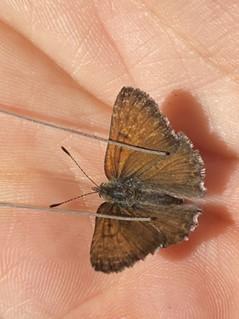
Bumble Bee Survey: Biologist Anderson surveyed for bumble bees at high elevation sites as part of the collaboration of WDFW and Xerces Society. The surveys are part of the Pacific Northwest Bumble Bee Atlas.

Probiotic Bat Capture in Darrington: Biologist Licence participated in a second round of captures at a Yuma myotis and big brown bat roost in Darrington. These captures are associated with a white-nose syndrome research project aimed at determining the efficacy of a probiotic treatment (among other things) to this devastating disease.

Biologist Licence co-lead a capture effort with Wildlife Veterinarian Dr. Haman targeting red foxes on San Juan Island. This project was initiated to conduct a baseline health assessment of the San Juan foxes for comparison to the endangered Cascade red fox population. Additionally, this provided an opportunity to optimize an immobilization drug dosing protocol and provided experience for a University of Washington PhD student currently planning a research project to conduct similar work on Cascade red fox. Outwitting a fox proved to be as challenging as one may guess, but the team did not leave empty handed and gained some valuable information and relationships. Many thanks to the participants that made this effort possible.


Bat Recon on Whidbey Island: Biologist Licence met with a north Whidbey Island landowner and Washington State Parks biologist to survey a bat roost in their attic and provide recommendations for supporting the local bats in this urban landscape. The visit generated great ideas and good will that appears to be formulating into a volunteer project with numerous roosting sites and bat boxes installed throughout the area.

Providing Recreation Opportunities
Access Meeting for GMU 418 Elk Hunters: Private Lands Biologist Wingard and District Wildlife Biologist Waddell hosted a meeting for archery and muzzleloader hunters who successfully drew a Quality Bull special permit in Game Management Unit (GMU) 418. For several years, Sierra Pacific Industries (SPI) has partnered with WDFW to allow free motorized access to specific areas on SPI lands for GMU 418 elk hunters. Hunters attending the meeting were provided with details about the North Cascades elk herd, access rules, and a key to unlock specific SPI gates during their hunt. The Department is grateful to Sierra Pacific Industries for this partnership and the tremendous access opportunity they provide to our special permit elk hunters.
Providing Education and Outreach
Biologist Licence coordinated with community members of the City of Langley to provide brochures on the harms of feeding wildlife. Brochures will be mailed to the community with monthly utility bills and will aid in discussions to investigate implementation of a local ordinance against feeding wildlife in the city.
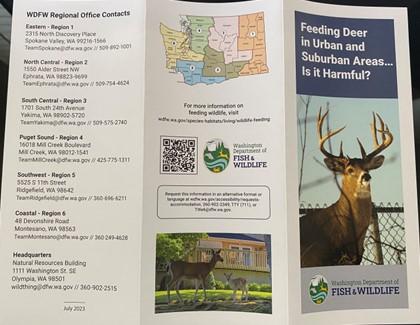
Providing Conflict Prevention and Education
Injured Owl: Biologist Wickhem and Volunteer Downing responded to a report of an injured great-horned owl near BZ Corners in Klickitat County. The owl had been seen perched on private property with what appeared to be a broken wing. The pair found the owl tucked underneath several stacked pieces of thick, metal trailer decking. Volunteer Downing was able to gently coax the owl out from under the decking with a long stick and Wickhem easily captured the tired bird as it emerged. The owl was taken to Rowena Wildlife Clinic for assessment. Unfortunately, the veterinarian said the break was more than a week old and too much bone was exposed for the wing to heal properly, so she decided to euthanize the owl to spare it from any further discomfort.

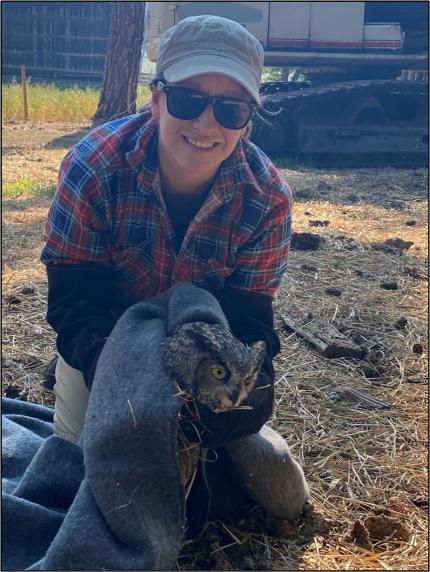
Agricultural Damage: Wildlife Conflict Specialist Aubrey met with landowners throughout District 10 experiencing damage to agriculture from deer and elk. Damage prevention cooperative agreements were drafted and signed.
Possible Cougar Sighting: Wildlife Conflict Specialist Aubrey placed a trail camera at a residence to monitor a potential cougar sighting.
Conserving Natural Landscapes
Mowing at Shillapoo Wildlife Area. In preparation for fall and the arrival of migratory waterfowl, large scale mowing activities have begun at the Shillapoo Wildlife Area. The mowing of tall, mature grasses encourages new growth, providing excellent forage for the geese, ducks, and sandhill cranes that will begin arriving later this fall. In some areas such as Vancouver Lake, the mowing is done in phases to provide temporary habitat and cover for pheasants that are released by WDFW for hunting opportunities at Shillapoo Wildlife Area.

Shillapoo and Mt. St. Helens Wildlife Area: Purple loosestrife is arguably one of the prettiest weeds growing on WDFW lands, and it is also on the priority list of noxious weeds treated by wildlife area staff members. Well known to people in other parts of the county where purple loosestrife has taken over vast amounts of shoreline, purple loosestrife often goes under the radar here in western Washington. It is often overlooked as just an attractive wetland plant with purple flowers. Through the months of July and August, Shillapoo and Mt. St. Helens wildlife area personnel visited and revisited many purple loosestrife sites to ensure this noxious weed is controlled effectively and its spread is prevented.


Managing Wildlife Populations
Oregon Spotted Frog Recovery: Biologist Tirhi and Real Estate Services Specialist Buck met with a landowner in the Allen Creek drainage of Thurston County to discuss his interest in purchasing an existing WDFW conservation easement on the neighboring property. Tirhi is continuing to contemplate and discuss with the landowner a possible future where his desire to graze cattle and/or hay would promote the objectives of spotted frog habitat improvement within the easement.
North American Bat Acoustic Monitoring (NABAT): Biologist Tirhi spent time uploading the District 11 NABAT data obtained from the four deployed acoustic monitors. Biologist Butler will likewise be uploading data from her four deployed locations. Data will be analyzed by WDFW Bat Species Lead Tobin. See July 2023 Highlights for explanation of this annual bat monitoring project.
Western Bumble Bee Monitoring: Western bumble bee is a candidate species for listing due to its dramatic decline across Washington and the west. For this reason, WDFW and partners have been conducting bumble bee surveys over the past several years. Based on a credible report of western bumble bee in Dupont, Biologists Butler and Tirhi and volunteer Cheney spent a day conducting surveys at two nearby locations in Steilacoom. Although several other species were captured and photographed that day, no western bumble bees were located. The public is encouraged to report any suspected western bumble bees at WDFW wildlife reporting form. Please include good photos/video from several angles.

Western Pond Turtle: Biologist Murphie deployed two artificial basking structures at the western pond turtle recovery site in District 15. A PIT tag (passive integrated transponder) antenna array was placed at the pond and fitted to one of the platforms. Trail cameras were also placed to collect images of turtles using the platform. Over 300 turtles were released in this pond from 2005-2013. All the turtles released are uniquely marked and have a PIT implant. The objective of this effort is to see if the PIT tag antenna array can identify remaining turtles released into the pond. Secondarily, we are looking for turtles that are unmarked and potentially new recruits hatched at the pond. Biologist Murphie has counted 36 turtles basking at various locations around the pond and positioned one of the basking platforms with antennas adjacent to basking logs with the most current activity. After a month of deployment and monitoring, it doesn’t appear that the platform is getting any use by turtles. This may be related to the “newness” of the platform, availability of other structures for basking, or simply that the platform is not in the right place. Regardless, Biologist Murphie removed the monitoring equipment on Aug. 30 and will try again next season. He intends to leave the platforms deployed over the winter and plans for an earlier deployment of the monitoring equipment next season.
Mourning Doves: Biologist Cent wrapped up trapping and banding mourning doves. The mourning doves seemed to arrive later this year, and numbers were lower than normal. She banded 52 doves during this year’s trapping efforts.
Beller’s Ground Beetles: In an effort to identify new populations of Beller’s ground beetles, Biologist Cent conducted reconnaissance of two sphagnum bogs (the habitat of these beetles) in Grays Harbor and Pacific counties. These efforts will continue next August once additional land access permits have been approved.
Bat Acoustic Surveys: Biologist Cent conducted District 17’s annual bat acoustic surveys. She deployed four acoustic detectors overnight in order to detect bat presence and identify species at various habitats within the district.
Providing Recreation Opportunities
Hunting Prospects: Biologists Butler and Tirhi further updated District 11 game species data spreadsheets. Biologist Tirhi used that data to update the 2023 Hunting Prospects for District 11. New this year is better informed game harvest data for small game and upland bird species provided by headquarters. Hunters having general questions related to hunting in any district should first be directed to the Hunting Prospects.

Sooty Grouse: Biologists Butler and Tirhi recovered three acoustic monitors for sooty grouse that had been deployed in spring, along assigned monitoring routes in the southern portion of District 11. The data (over 2,000 files) from each monitor was downloaded to HQ as requested. The data will be analyzed by the Small Game Section lead by Species Specialist Garrison.
Wolf Monitoring: Biologist Tirhi and Volunteer Cheney spent two days changing batteries and SD cards on trail cameras deployed in the Carbon River and White River drainages of District 11. The SD cards are screened by Volunteer Terry and then later redeployed. While credible reports of individual wolves have been reported in the district, no wolf or wolf packs have been confirmed within District 11 to date. This monitoring is done in partnership with Northwest Trek, U.S. Forest Service, Manulife, and Conservation Northwest.

Olympic Goat, Deer and Elk Status and Trend Reports: Biologist Murphie completed updates to the Olympic goat, Olympic deer, and Olympic elk status and trend reports. Other data work associated with these write-ups was also completed. Reports are now available for supervisor review.
Union River Wildlife Viewer: Partners at the Hood Canal Salmon Enhancement Group installed a wildlife viewer provided from WDFW’s Watchable Wildlife Program at the Union River Unit in Belfair. The viewer includes an ADA accessible attachment as well as autocorrection lenses for color-blind viewers.

Olympic-Willapa Hills Wildlife Area: Construction of a new 3,000 square foot pole barn was recently completed at the Olympic-Willapa Hills Wildlife Area headquarters. The staff members there utilize a range of machinery and standard farm equipment in managing the wildlife area, some of which has had to be stored outdoors throughout the winter simply due to a lack of sheltered storage space. The building has been a regular capital budget request item dating back to at least 2008, and its construction now fulfills this long-term need.

Pierce County - Crescent Lake: The access team repaired potholes, weather cracks, and washout areas with asphalt repair on State Game Access Road in Gig Harbor which is the access road to Crescent Lake water access. The area of asphalt is over 500 feet long these efforts took 13,000 pounds of cold patch asphalt. Another 400 feet of gravel roadway was graded with minor potholes filled in. This roadway has been an area of contention with residents, Pierce County, and WDFW. No one knew who was responsible for the maintenance and each believed it wasn’t their responsibility. Water access made these repairs for now with future talks between Pierce County Works and WDFW to take place in the future.
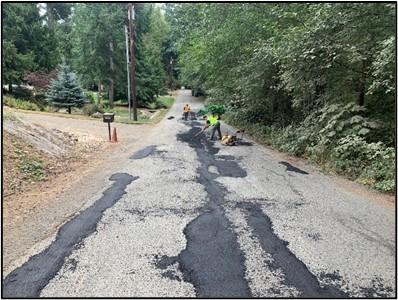
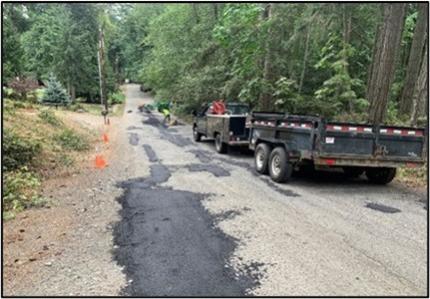

Kitsap County - Kitsap Lake, Long Lake and Wildcat Lake: The access team worked with Washington Conservation Corp on installing new monofilament recycling tubes. The collaboration has resulted in eight additional WDFW access locations with the collection sites, including three in Kitsap County. The expansion has been in the works for several months, approximately 25 more recycling tubes will be installed at access sites across all eight regions and six counties.
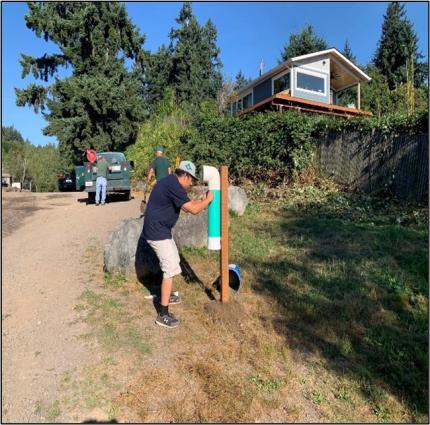

Grays Harbor - Chehalis River and tributaries: The access team, with assisstance from Enforcement, cleaned up several dump piles and an abandoned vessel left in the Chehalis River
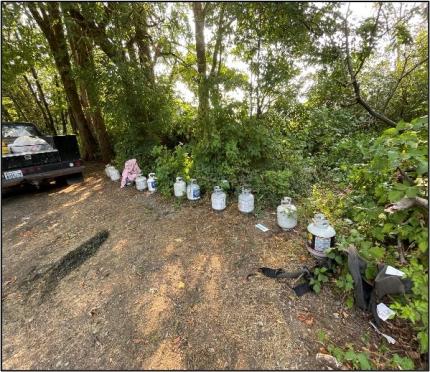

ADA Maintenance: The access team also has continued painting restrooms where needed and began refreshing preparing and painting ADA parking stalls, curbs and replacing signage as needed.

Conserving Natural Landscapes
South Puget Sound Northwest Youth Corp: A Northwest Youth Corps (NYC) crew continued to do weed control and site clean-up at the unit in Lakewood through collaboration with the Clover Park Rotary Club.

Oregon spotted frog habitat maintenance: Biologists Butler and Tirhi each oversaw Washington Conservation Corps (WCC) work groups which were hired to cut invasive reed canary grass that invades and threatens listed Oregon spotted frog breeding sites. WCC crews are hired annually to provide this assistance. One day each was spent at our Salmon Creek, Allen Creek, and Mima Creek recovery sites. The work crews focused on cutting grass within specific plots that are the focus of research on the use of the herbicide Imazapyr to impede canary grass growth and thus increase the efficiency of mowing (e.g. reduce the rate/need to mow). The effect of Imazapyr on reed canary grass, on spotted frogs directly, and bioaccumulation at treatment sites is being investigated. WCC crews will return to Salmon Creek for two more days in September and Allen Creek for one day in October for additional mowing.
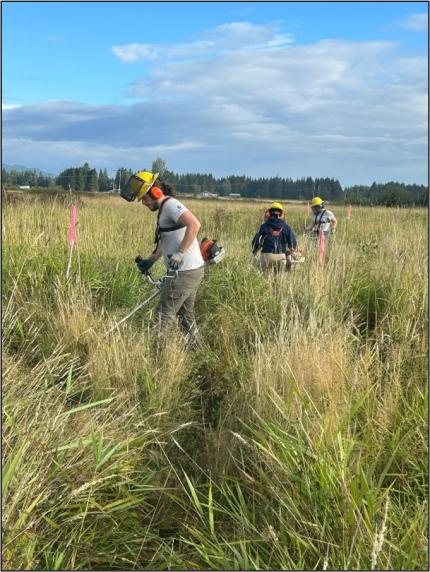

South Puget Sound Weed Control: Weed Specialist Heimer assisted Wildlife Area Manager Laushman in knotweed control along Chambers Creek at the South Puget Sound Unit in Lakewood.

Noxious Weed Control: Biologist Novack and Cent spent a week operating a skidsteer with a brush hog to mow invasive blackberries at Davis Creek Wildlife Area, Hoxit Wildlife Area, and the Region 6 headquarters in Montesano.
Providing Education and Outreach
General Wildlife Inquiries: Biologist Murphie responded to inquiries received by phone, email, or in person related to bear, elk, deer, pocket gopher, waterfowl hunting, squirrels, and bats.
Conducting Business Operations and Policy
Aircraft Safety Training - Instructor: Biologist Murphie provided a basic airplane and helicopter class at the Natural Resource Building in Olympia this period. Staff members from the Fish and Wildlife programs attended.
Other
Status and Trends: Biologist Novack submitted draft versions of the Status and Trends report for Willapa Hills deer and elk.
SOBA Training: Water Access Manager Reeves participated in the SOBA (States for Boating Access) symposium. The symposium is where state, federal, and private agencies gave presentations in relation to grants funding and displayed new technology and successful projects for any and all things associated with boating, boating access and industries, and related fields. Several individuals from WDFW gave great presentations.